Industry Outlook: A new chapter for personnel lifts
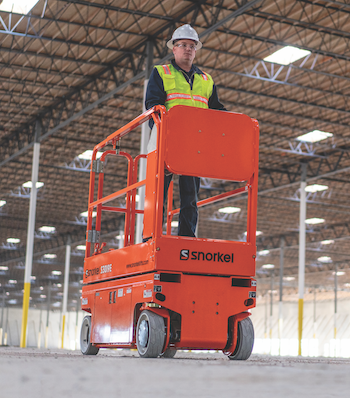 |
| MEWPs reduce user fatigue, provide a larger workspace and offer an easy-to-maneuver option on a worksite. Ladder manufacturers have responded to increasing safety concerns by adding features to their products like cages, podium steps and outriggers, but they still don’t compare to low-level lifts when it comes to prolonged elevated work. |
Low-level lifts and leak prevention gain popularity with rental customers.
The issues aren’t insurmountable, they report, and the growing trend for contractors and other end users to require MEWP use over ladders and scaffolds for safety and productivity reasons bodes well for this leading equipment rental category.
Pro Contractor Rentals queried leading MEWP providers for their thoughts on MEWP equipment trends; here is what they shared.
 |
|
Lenny Polonski, founder, All Access Equipment |
Push for multi-task equipment
The latest trend is to invest in equipment that can multitask with more capabilities so contractors can do more with less and not tying up capital in specialized equipment.
Narrow-access compact boom lifts fit this role well. They have the ability to safely reach up to 135 feet in height, enter any standard 36-inch door, set up in seconds even on sloped floors such as auditoriums.
ANSI standards will require operator and worker training, but it is not rocket science. For example, All Access equipment automatically trains personnel and takes very little time for anyone to master operation.
Rental customers need equipment that is simple to operate and helps them complete their work faster and more efficiently. Previously, control systems in this type of lift were complicated and required a time-consuming learning curve.
Rental centers should consider the latest and newest equipment that has simple to operate controls and understand the benefits of such equipment. How will this help my customers consider renting increase their productivity? Will it increase their versatility? All of these factors play a part in the true ROI of a piece of equipment in the rental industry, and the goal is to make work easier for the rental customer.
 |
| Mike Flanagan, Genie product manager, Terex AWP |
Indoor/outdoor challenges and opportunities
End users are focused on what brings value and productivity to the job site. In applications where a 19-foot platform height machine is not a necessity, for example, we are seeing increasing demand for low-level access products, such as the micro-sized Genie GS-1330m scissor lift, which is designed to offer end users the productivity of a slab scissor lift in a footprint and weight that can meet the access challenges many modern job sites present. Whether it is a data warehouse full of sensitive servers, or a grocery store with full shelves, compact machines like the Genie GS-1330m scissor lift are being favored and driving adjustments to the rental fleet mix.
The new ANSI/CSA standards in North America may not drastically affect the selection of available products, but rental centers and end users will be faced with changing performance specifications. Historically, ANSI/CSA have not differentiated between indoor or outdoor use. Machines compliant with the new North American MEWP standards are aligned with ISO-based standards such as those found in European markets, where machines are required to modify performance specifications on whether they are operated in areas where there is no wind (indoor) or in areas exposed to wind up to 28 mph.
As MEWPs align with ISO standards regarding indoor and outdoor use, end users and rental centers will need to adjust their fleet mixes to meet the needs of their job sites. The distinction between indoor and outdoor use can be confusing; for example, in areas where there may be a roof — but no walls — would actually be considered outdoor use. With this in mind, Genie has introduced the Genie Smart Link dual-zone control system across all slab scissor lifts and vertical masts. This control system permits machines that are indoor models, such as the Genie GS-1330m, GS-1930 and GR units to be able to be operated outdoors, improving rental utilization potential and productivity.
 |
| Justin Kissinger, vice president, marketing Hy-Brid Lifts |
Personnel safety takes center stage
There are two key trends that experts at Hy-Brid Lifts are seeing impact the MEWP industry: ANSI standards and operator safety. They go hand in hand; the ANSI updates were created to increase safety for the operator.
The new ANSI A92.20 update should be in place in March 2020. The design changes that affect manufacturers range from small adjustments to larger ones, and include folding rails, indoor/outdoor ratings, capacity ratings and more.
With the increase in required rail height, many manufacturers are using folding rails. Hy-Brid Lifts made it a priority to avoid them on the PS-1930, our newest lift. With non-folding rails, operators can save a step by not having to stop and fold down the rails before going through a standard doorway.
Hy-Brid Lifts engineers incorporated other compliant features as well, including full gated entrances, wind ratings and load-sensing capabilities. The new standard requires machines to have load sensing that prevents all lift operations if the rated capacity is exceeded. To resume operation, weight will need to be removed. Hy-Brid Pro Series include updated upper controls that allow the operator to check what percent of the rated capacity is on the platform to prevent overloading. These lifts also have increased platform capacities to minimize the chance of overloading the lift.
The Pro Series also includes LeakGuard, which is Hy-Brid’s cutting-edge fluid containment system. This system provides an alternative to diapers, which are often the only option when it comes to protecting delicate flooring. Diapers can tear and cause unnecessary work interruptions, so LeakGuard aims to prevent that.
The new standards reaffirm Hy-Brid Lifts’ belief that it is on the forefront of cutting-edge design with customers’ safety and productivity in mind. Many of these additions and developments were already in Hy-Brid Lifts’ plans for future lift designs.
Safety is of the utmost importance to lift manufacturers, and Hy-Brid Lifts employees stand behind its “ladders last” tagline. While it might seem like just a catchy phrase, it accurately demonstrates the belief that job sites can almost do away with ladders. While they do have a time and a place on job sites, workers rarely utilize them safely, putting themselves and their employer at risk.
MEWPs reduce user fatigue, provide a larger workspace and offer an easy-to-maneuver option on a worksite. Ladders can’t compare to low-level lifts when it comes to prolonged elevated work.
After rental customers realize the benefit of choosing a lift over a ladder, it’s important they choose the correct size lift. An oversized piece of equipment can be dangerous on a job site, presenting crushing hazards and overall inefficiency. By recommending the best lift for the situation, rental centers can help prevent injuries and increase productivity.
There are variations beyond lift height that affect a customer’s choice: platform ratings, lifting capacities and number of operators allowed on a lift. Rental centers should become familiar with not only the ANSI changes, but also the lifts in their offering. Making a knowledgeable recommendation to help fit the customer’s job site needs can result in an efficient, safe operation.
 |
| Joshua Wells, access product manager, JCB North America |
Electric drives gain popularity
MEWPs are the most rented machine in the industry. Although often used only a few times a year, they are essential for many maintenance projects and other tasks performed at height. Design innovations and technology offer noticeable improvements.
As with any machine that runs on hydraulic power, any brand of MEWP may be prone to releasing some hydraulic fluid during use. A common trend calls for leak containment with the addition of drip pads or electric-drive options, allowing for cleaner usage, longer battery life and increased efficiency.
Customers are demanding machines that eliminate potential leaks and can be used on finished floors without the need for clean-up. It’s also important to operators to work safely, especially in food environments, hospitals and schools. Leak containment provides a safer, cleaner environment, ultimately saving the customer money but also allowing the operator to be a good steward of his or her job site.
Telematics is becoming increasingly common on MEWPs. Features such as machine location tracking, service and error codes, maintenance alerts, geofencing and battery life updates are possible with telematics innovations. JCB currently offers the Livelink Lite system on its scissor lifts and an operator app that enables remote daily checks.
Job sites are experiencing an increase in battery theft. JCB now fits all JCB MEWPs with a locking battery tray, which has proven to be a valued feature by customers.
The updated ANSI standards bring a new range of challenges to indoor MEWP use. Communication and education about the new ANSI standards are critical to ensure smooth integration into existing rental fleets.
On the manufacturer side, aerial lifts will be required to have load-sensing technology that will limit or cease operation when the platform is loaded greater than capacity, allowing for safer use of the machine. JCB has had the load-sensing feature on its MEWP design since they launched in North America.
Additionally, the new standards have the potential to improve productivity and profits as every supervisor and operator will be required to receive MEWP training prior to use. These standards have the potential to reduce downtime and increase safety and productivity. For example, an untrained operator might stop work to call the rental company or his supervisor to report a machine malfunction. A trained operator, however, will know the cause of the alarm and will take necessary action to reduce the load, avoiding lost time for an unwarranted phone call.
While changes are forthcoming regarding trends and regulations, some things remain the same. Rental companies will consistently demand reliable machines that maintain residual values. Additionally, MEWPs will continue to be the go-to rental known for its robust design, easy maintenance, and long-life span – a dependable machine that contributes to a safer, more productive work environment.
 |
| Jordan Cuadrado, product manager |
Smaller units improve access
The current major trends for indoor MEWPs are focused on the scissor stack height and oil-catch systems. Manufacturers are working to decrease the scissor stack height by allowing the stack to sit lower in the chassis. This allows machines to pass through standard doors without the need to fold down the rails.
As of right now, most scissors have hydraulic lift systems, so manufacturers are working on oil-catch systems to prevent oil spills on the job site.
The new ANSI standards have two major changes that will affect indoor MEWP use. The first change of the ANSI standards determined that rail height must be at least 1.1m (43.3 inches) tall. Because of this, manufacturers are incorporating folding rails; others are rethinking their scissor stack design.
The second change of the ANSI standards is overload sensing, which will prevent scissor lift operation if weight exceeds maximum capacity. The customers’ selection of indoor units will be largely determined by the estimated load that lift will be experiencing. The overload sensing will reinforce the idea of “use the right tool for the job.” The end user will not be able to fully utilize a machine that has a lower capacity than what the job is demanding. It will now be up to the user and/or the dealer to educate themselves and each other on what lifts should be used for which application.
The most common issues that rental customers have are the rail height and the weight of the unit. Most manufacturers are selling products that are already ANSI 92.20 compliant such as LGMG, the rail height situation is becoming more concerning with end users as they don’t want the downtime of folding the rails every time they go through a standard doorway. The weight of the unit is always a concern when they want the lift to go up elevators or on sensitive ground.
Rental centers can help address those concerns by becoming more versatile with their equipment options and offering alternatives to their customers. Many of these concerns can be solved by offering smaller MEWPs such as the 12- and 14-foot micro scissors instead of the common 19-foot size. These scissors have lower rail heights and weigh much less and can complete most indoor jobs.
The lack of knowledge of the ANSI 92.20 is still apparent. This is the first time that there will be a clear split from indoor/outdoor use for scissor MEWPs and customers will have to learn what can be used for which application.
 |
| Michael Sover, North America product marketing manager - MEWPs Manitou |
Users looking to lowest total cost of operation
The current market demand for indoor and outdoor MEWP, is increasing. The U.S. rental market continues to grow in terms of size and the total number of units; the construction segment dominates the overall MEWP rental market.
Increasing utilization and reducing the total cost of ownership are two trends driving customer demands. Manitou MEWPs come standard with Manitou’s telematics program, Connected Machine, to help simplify increasing machine utilization. It gives customers the ability to remotely track machine location, view machine performance data to respond to machine issues in the field and proactively schedule machine maintenance. It allows Manitou MEWP users to run their business more efficiently than before.
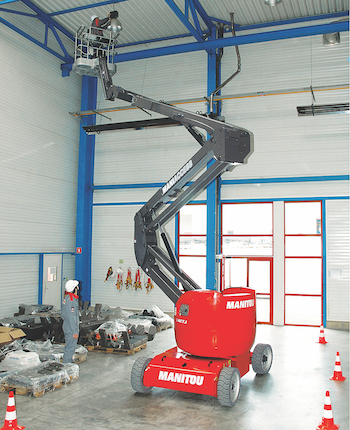 |
|
Looking toward total cost of ownership (TCO), customers are considering all costs associated with a machine. On Manitou AETJ 43 and AETJ 49 electric MEWPs, users will find traction batteries that provide approximately 1,300 cycles (6.5 years) before replacement is needed. |
Looking toward total cost of ownership (TCO), customers are considering all costs associated with a machine. That’s why on Manitou AETJ 43 and AETJ 49 electric MEWP’s, users will find traction batteries, that offer approximately 1,300 cycles (6.5 years) before replacement, as standard.
When Manitou launched its MEWP product line into North America, all machines were already complied with the new standard. The new ANSI A92 standard calls for more training for platform operators. Operators and supervisors will also need additional training to better understand the machines’ operation. Training will include becoming familiar with the new features of the machine, proper MEWP selection, applicable rules and regulations, potential hazards associated with MEWP use and be knowledgeable about the manufacturer’s operation manuals. MEWP occupants will also require additional training.
One of the more common issues when renting an indoor MEWP is making sure you get the correct machine to handle the job. Customers need to choose a machine with a suitable platform working height and horizontal outreach that will meet to the job requirements. The MEWP should be easy to operate with an intuitive control panel. Since it will be for indoor applications, ideally, it would be best to use an electric vs. a diesel-powered machine. Most indoor applications require solid tires that are non-marking. It’s important to know the machine width in case it needs to go through narrow openings or aisles on the job site. The customer should also confirm that the product meets the new ANSI A92 standard.
 |
|
Mitch Fedie, marketing manager, Pettibone |
New to MEWP market
Pettibone has just entered the MEWP market with 13 scissor lift models. The machines with work heights of 25 to 33 feet with deck widths of 32 inches will be the most popular; these models allow operators to maneuver through tight indoor spaces like doorways. They are also lighter so they can be used on more delicate floor surfaces. Some configurations, like the Pettibone SS1932E, can be transported in an elevator.
The biggest trend right now with electric scissor lifts is ensuring that units are ANSI 92.20-compliant. Some of the ANSI requirements include clear indoor vs. outdoor designations, load-sensing systems, tilt-angle cutout systems, self-closing doors and higher guard rails. Along with the new standards there are also more stringent requirements of safe use of the equipment and documentation of operator training.
Competition in the scissor lift market has certainly been increasing over the past few years. OEMs that have entered the market are providing machines that have impressive performance and build quality, along with competitive pricing that is attractive to rental houses and end users.
The increase in competition gives end users a greater variety of models and options from which to choose when selecting an electric scissor lift. New manufacturers are also offering aggressive pricing that could give a smaller, more regional rental house the ability to be competitive when quoting against larger rental houses.
Pettibone marketers expect to see rental houses and end users replacing their current fleets with the updated scissor lifts so that they are using the safest, most up-to-date equipment on the market.
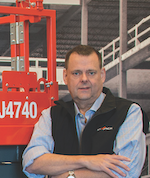 |
| Malcolm Early vice president, Marketing Skyjack |
Updated indoor/outdoor requirements
Over the past two years we’ve seen an increased demand for more stringent on-site safety measures. The new ANSI standards, and OEMs like Skyjack that have gone above and beyond those, have addressed these changes through implementation of secondary guarding. Skyjack’s Secondary Guarding Lift Enable (SGLE) features a two-handed lift function to help keep the operator’s body away from the railings while rising, mitigating the risk of entrapment.
We’re also seeing an increasing trend toward telematics on all types of equipment. Skyjack’s Elevate telematics solution is designed to provide value on even low-cost, high-volume machines like vertical masts and compact scissor lifts.
Due to new wind force requirements, some equipment ratings have changed and some models are no longer rated for indoor and outdoor use. Wanting to keep Skyjack’s Next generation of equipment as close to its predecessors as possible, Skyjack looked at ways to maintain outdoor ratings on the SJ3219 model. The SJ3219 is the lightest scissor lift on the market that maintains an outdoor rating at full height.
With the new ANSI standards, the biggest issues that rental customers will have with any MEWP, indoor or outdoor, is awareness of the changes. Load sensing will now be standard and equipment won’t operate when overloaded, so it’s important to pay attention to the machine requirements.
There are also new training requirements under A92.24 standards that need particular attention. A large one is ensuring that an occupant is trained in case of an emergency and the operator cannot bring the platform to ground level. It is yet another example of how standards save lives.
Skyjack has published a host of information to help rental companies and end users better understand the standards, what they mean for our industry, and how they’ve impacted our equipment. The list of documents can be found online at www.skyjack.com/ansi-update.
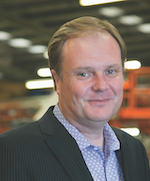 |
| Matthew Elvin, CEO Snorkel |
Low-level MEWPs gain popularity
Greater fall prevention efforts can increase low-level MEWP demand.
In the past few years, there has been an increasing focus on low-level MEWPs, which are most commonly used indoors. Low level generally refers to MEWPs that have a working height of less than 16 feet and are a direct replacement for traditional indoor work at height platforms, such as step ladders and scaffolding towers.
Data from OSHA and other sources show that falls from height are one of the most common types of job site injuries, and a significant proportion of those are falls from heights of 15 feet or lower. Low-level MEWPs offer a safer alternative to stepladders and scaffolding towers, while also helping to increase operator productivity, thanks to space in the platform to carry tools and materials to the working area and around the job site when in stowed position.
Low-level MEWPs are generally lightweight and compact so they can be carried in passenger elevators, pass through standard doorways and are available in push-around and self-propelled models, making them ideal for use in large, multi-story buildings.
Many large, global contractors have adopted low-level MEWPs in volume on their projects and that has helped to drive demand through the rental channels – particularly in high-density urban areas where there are many high-rise buildings.
Snorkel was one of the first major manufacturers to introduce a line of low-level MEWPs, and today offers a range of three mini push-around scissor lifts with platform heights ranging from 6 feet 6 inches to 9 feet 10 inches, plus a self-propelled version, the Snorkel S3010E, with a platform height of 9 feet 11 inches. These are offered in addition to the range of full-size Snorkel electric slab scissor lifts, ranging from platform heights of 15 to 32 feet, and self-propelled mast lifts, which can all be used indoors.
Compliance with the new standards means manufacturers will restrict many personnel lifts to indoor-only operation. In the past, these machines were commonly used outdoors with wind ratings that may not have met the new requirement of 28 mph. Under the new standard, to be outdoor rated in any wind requires that equipment meet the 28-mph requirement or it can only be used in an indoor environment, protected from any wind. Indoors next to a garage door with wind blowing in is still considered outdoor usage.
In the United States, there has been a fairly slow adoption rate of low-level access solutions to replace traditional means, such as ladders and scaffolding towers, as well as larger indoor MEWPs which are being under-utilized and are generally more difficult to maneuver in tight indoor spaces.
 |
| Alain Paré, Aerial Specialist Up Equip |
Trend toward low-level lifts
Rental houses are slowly coming on board to acquire more niche low-level lifts. Unfortunately, the capital expense budget for niche products is usually close to zero. Still, Up Equip is dedicated to these niche products and the Up Equip fleet is steadily growing.
Very few rental houses position themselves as solution for niche products, but Up Equip expects to see steady growth over the next few years, but it takes time. Niche lifts tend not to put instant and immediate profit to the bottom line, so they don’t fit most business models that call for instant and fast profits.
This is a conservative industry. While it seems the choice of solutions for indoor lifts is narrow and if the sales representative looks only at the very few solutions at his or her disposal, it doesn’t mean there is no solution. This lack of curiosity and doing the extra step to find a real solution for the customer contributes to the lack of investment in these types of niche products by rental centers. If you do what you have always done, you will get what you have always gotten.
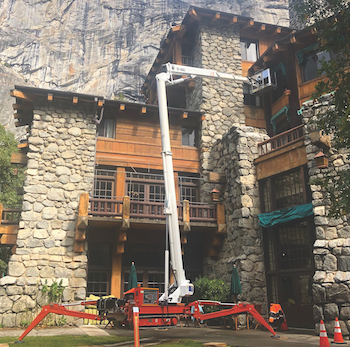 |
|
Several indoor lifts can also be used outdoors; new ANSI standards require models to be rated for indoor, outdoor and both indoor/outdoor use. |
Manufacturers are meeting the new ANSI standards with new models. The options put at customers’ disposal will have to meet these requirements and end users will be offered solutions that meet those requirements.
The most common customer need is for up-and-over side reach, or ability to reach horizontally. Standard straight scissor lifts are perfect for straight-up vertical elevation is required but they do not allow any side reach. Floor capacity is also quite often a challenge. Compact tracked lifts overcome most of the objections raised by structural engineers because the ground pressure is very low.
The most challenging part of adoption of low-level indoor lifts is lack of knowledge about the products available. Low-level niche MEWPs are known and understood by only a few rental center managers. Rental houses in general are not ready to invest the time required to understand where these units fit and therefore won’t invest in them.
Up Equip experts believe the future will belong to those who step outside the box and establish themselves as being different. It’s okay to remain the same due to the nature of things, but there is yet a great market to own, and the first one(s) will acquire an edge that will be difficult to beat. For example, the adoption of Easy Lift spider lifts, or any brand for the matter, will not happen by itself. Rental houses need to invest time and money to understand how these units work so they can pass this knowledge on to end users. The old response of “sending a tech” isn’t going to work with those lifts when a customer has a problem with a spider lift because 95 percent of the time, the lift doesn’t need repair, the problem is with the operator. We have found those issues can be resolved with a single phone call.
This article appeared in the March-April 2020 issue of Pro Contractor Rentals magazine.
© 2020 Urbain Communications LLC. All rights reserved.











